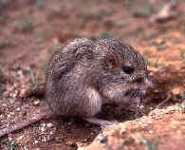 The desert pocket mouse (Chaetodipus penicillatus) lives in the desert regions of the southwestern United States, including Nevada, Arizona, parts of New Mexico, Texas and California, the Baja Peninsula and northeastern Mexico. It prefers dry, sandy regions with little vegetation. It's not generally found in rocky areas.
The desert pocket mouse (Chaetodipus penicillatus) lives in the desert regions of the southwestern United States, including Nevada, Arizona, parts of New Mexico, Texas and California, the Baja Peninsula and northeastern Mexico. It prefers dry, sandy regions with little vegetation. It's not generally found in rocky areas.Common desert pocket mouse habitats include dry stream beds, desert washes or arroyos. The little vegetation around may consist of cacti, yucca, mesquite, palo verde or creosote bush.
The desert pocket mouse is a granivore, meaning seeds make up its diet. It burrows into the desert soil to find seeds from grasses or shrubs. It may occasionally supplement its diet with insects. The desert pocket mouse has cheek pouches to store seeds in, and it also builds burrows to store seeds for the winter. In some areas, the desert pocket mouse may go into partial hibernation for the winter months, waking only often enough to eat stored seeds.
Interestingly, there's no evidence a desert pocket mouse drinks water. It seems to extract as much water as it needs from the seeds it eats. This helps it to live in an arid desert climate.
The average length of a desert pocket mouse is 180 millimeters, or seven inches. Of that length, more than half--about 110 millimeters--is its tail. Average weight varies from 11 to 22 grams, or .
The desert pocket mouse has sharp front incisors that help it to break through hard, dry desert soil to search for buried seeds. They tend to be solitary animals who forage at night. They compete with other members of the Heteromyidae family for food. It has natural predators, such as owls, but is not currently in danger of extinction.
The average lifespan for a desert pocket mouse is just one year whether in the wild or in captivity. During that year, a female may bear one or two litters from early spring to late summer. On average, gestation takes 23 days and a litter consists of four young, though it could be as few as one or as many as seven.
Keywords: nocturnal , hibernate
The Desert pocket mouse is listed as Least Concern (LR/lc), lowest risk. Does not qualify for a more at risk category. Widespread and abundant taxa are included in this category, on the IUCN Red List of Threatened Species
Namings for the desert pocket mouse
A young / baby of a desert pocket mouse is called a 'pinkie, kitten or pup'. The females are called 'doe' and males 'buck'. A desert pocket mouse group is called a 'nest, colony, harvest, horde or mischief'.
Custom Search